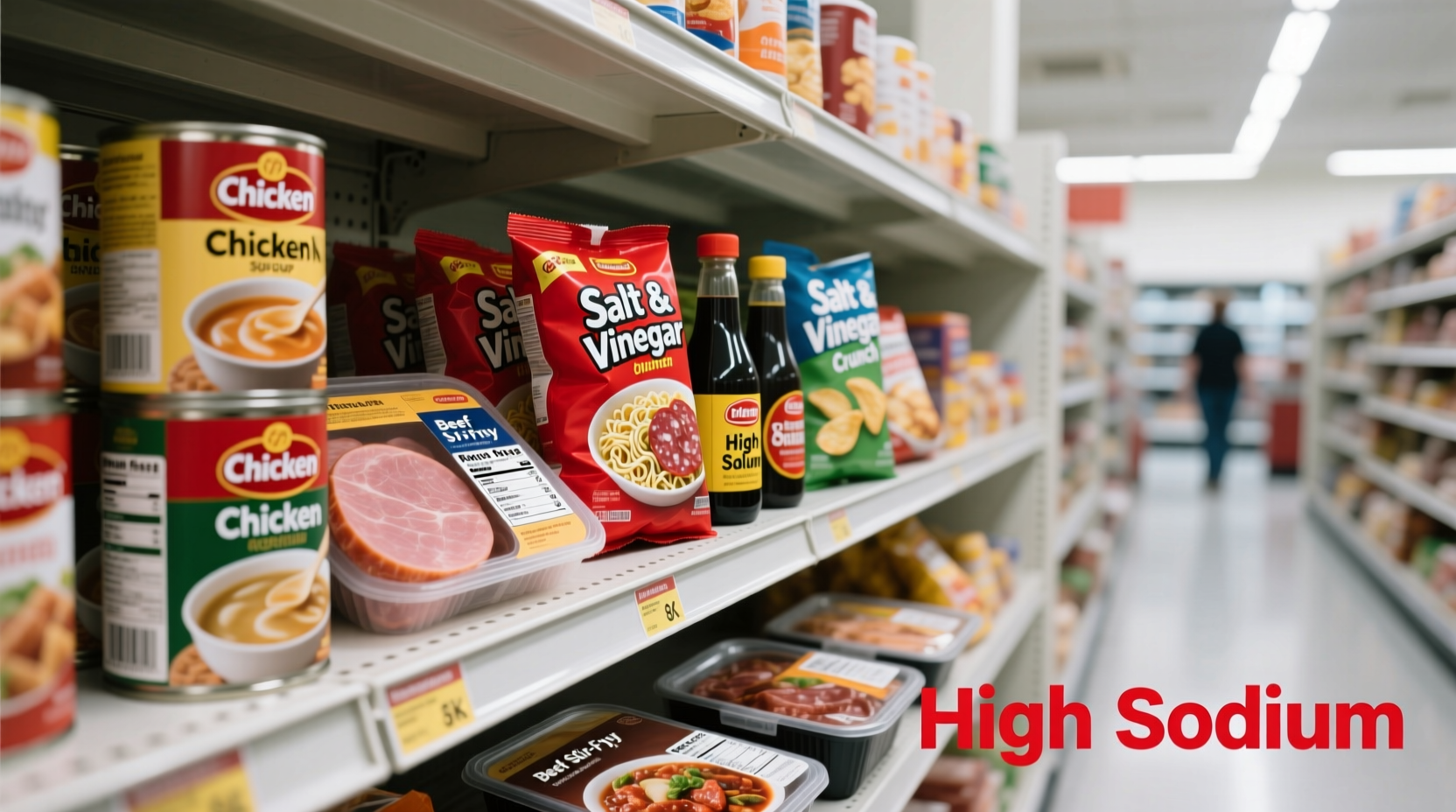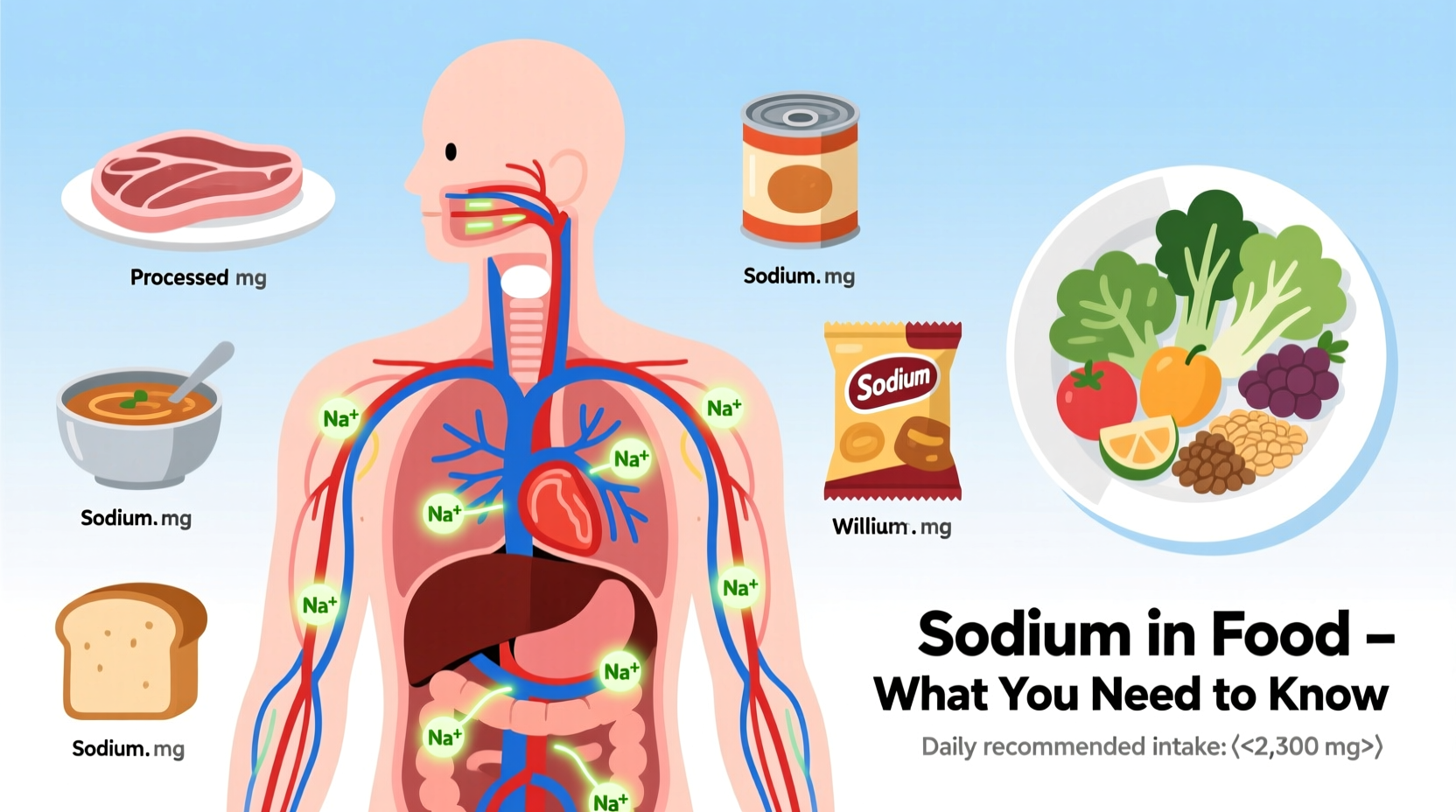Understanding sodium in your food isn't just about avoiding the salt shaker—it's about recognizing how this essential mineral impacts your health and where it's hiding in your daily meals. While your body needs sodium to regulate fluid balance and support nerve and muscle function, excessive intake contributes to high blood pressure and cardiovascular issues for millions of Americans.
What Exactly Is Sodium in Food Context?
Sodium is a chemical element (Na) that naturally occurs in many foods and is added during processing. When people talk about "sodium in food," they're typically referring to sodium compounds, most commonly sodium chloride (table salt). One teaspoon of salt contains approximately 2,300 mg of sodium—the maximum daily limit recommended by health authorities.
| Sodium Compound | Common Name | Sodium Content |
|---|---|---|
| Sodium Chloride | Table Salt | 40% sodium by weight |
| Sodium Bicarbonate | Baking Soda | 27% sodium by weight |
| Sodium Nitrate | Preservative | 27% sodium by weight |
| Sodium Benzoate | Preservative | 15% sodium by weight |
This fact对照 table shows how different sodium compounds contribute varying amounts of sodium to your diet. While table salt is the most recognized source, numerous additives in processed foods contain significant sodium levels that many consumers overlook when managing their intake.
Where Sodium Hides in Your Daily Diet
Most people are surprised to learn that only about 11% of dietary sodium comes from salt added during cooking or at the table. According to CDC data, the primary sources include:
- Bread and rolls (7.5% of total intake)
- Pizza (5.4%)
- Sandwiches (4.7%)
- Chicken (including poultry dishes) (4.3%)
- soup (3.9%)
- Burgers (3.5%)
- Pasta dishes (3.2%)
These seemingly innocent foods become significant sodium contributors because they're consumed frequently. A single slice of bread might contain 100-200 mg of sodium, which adds up quickly when you eat multiple servings daily.

Understanding Sodium's Health Impact Timeline
Sodium recommendations have evolved significantly as research has advanced. This timeline shows key milestones in our understanding of sodium's role in health:
- 1977: First Dietary Goals for the United States recommended reducing salt intake
- 1988: INTERSALT study established link between sodium and blood pressure
- 2005: Dietary Guidelines first specified 2,300 mg daily limit
- 2010: American Heart Association recommended ideal limit of 1,500 mg for most adults
- 2020-2025: Current Dietary Guidelines maintain 2,300 mg upper limit
This evolution reflects growing evidence about sodium's relationship to cardiovascular health. The consistent finding across decades of research is that most populations consume far more sodium than needed for optimal health.
Reading Nutrition Labels Like a Pro
When evaluating "what is sodium in food" from a practical standpoint, nutrition labels provide crucial information. Look for these key elements:
- Serving size: Compare to what you actually eat
- Milligrams (mg) of sodium: Listed directly under serving size
- % Daily Value (%DV): Based on 2,300 mg daily limit
Foods with 5% DV or less per serving are considered low in sodium, while those with 20% DV or more are high. Remember that %DV is calculated using the maximum recommended limit, not necessarily your personal ideal intake.
Context Boundaries: When Sodium Matters Most
Not everyone needs to monitor sodium equally. These context boundaries help determine when sodium awareness becomes critical:
- For healthy adults: Staying under 2,300 mg daily supports long-term cardiovascular health
- For those with hypertension: Limiting to 1,500 mg may provide additional blood pressure benefits
- For athletes: Increased sodium needs during prolonged intense exercise (consult sports nutritionist)
- For kidney disease patients: Strict sodium restriction often required (follow medical advice)
These context-specific recommendations highlight why blanket statements about sodium intake can be misleading. Your individual health status, activity level, and medical conditions significantly influence your optimal sodium consumption.
Practical Sodium Reduction Strategies
Reducing sodium doesn't mean sacrificing flavor. Try these evidence-based approaches:
- Gradually decrease salt in cooking—your taste buds adapt within weeks
- Use herbs, spices, citrus, and vinegar for flavor instead of salt
- Choose fresh or frozen vegetables without added sauces
- Rinse canned beans and vegetables to remove 30-40% of sodium
- Compare labels and select lower-sodium versions of packaged foods
- Request sauces and dressings on the side when dining out
Research shows that reducing sodium intake by just 1,000 mg daily could prevent 120,000 new cases of coronary artery disease over a decade. Small changes in your daily habits create meaningful health improvements over time.
Common Misconceptions About Food Sodium
Several myths persist about sodium in food that can hinder effective management:
- Myth: Sea salt is significantly lower in sodium than table salt
Fact: Both contain approximately 40% sodium by weight - Myth: If food doesn't taste salty, it's low in sodium
Fact: Many high-sodium foods like sweetened cereals and baked goods don't taste overtly salty - Myth: All sodium is bad for you
Fact: Your body requires sodium for essential functions—balance is key
Understanding these distinctions helps you make informed choices rather than relying on taste alone to guide your sodium decisions.
When to Consult a Professional
While general sodium guidelines apply to most people, certain situations warrant professional guidance:
- Diagnosed hypertension or heart disease
- Kidney disease or other chronic conditions
- Medications that interact with sodium levels
- Extreme athletic training requiring electrolyte management
A registered dietitian or healthcare provider can help create a personalized sodium management plan based on your specific health profile and dietary preferences.
How much sodium is in a teaspoon of salt?
One teaspoon of table salt contains approximately 2,300 mg of sodium, which equals the recommended daily upper limit for most adults according to the Dietary Guidelines for Americans.
What's the difference between sodium and salt?
Salt (sodium chloride) is a compound that's 40% sodium by weight. When discussing food labels, 'sodium' refers to the sodium component of various compounds, while 'salt' typically means sodium chloride. One gram of salt contains about 400 mg of sodium.
Which foods naturally contain sodium?
Many whole foods contain natural sodium, including milk (about 50 mg per cup), eggs (about 70 mg per large egg), and vegetables like celery and beets. However, these natural sources contribute minimally to total intake compared to processed foods.
How can I identify hidden sodium in packaged foods?
Check ingredient lists for sodium-containing compounds like sodium benzoate, sodium nitrate, monosodium glutamate (MSG), and baking soda. Also look for terms like 'soda,' 'sodium,' and 'brine.' Foods with more than 400 mg per serving are considered high in sodium.
Does reducing sodium intake really improve health outcomes?
Yes, multiple studies show that reducing sodium intake lowers blood pressure. The CDC reports that cutting sodium by 400 mg daily could prevent 28,000 heart attacks and 24,000 strokes annually in the U.S. Long-term reduction supports cardiovascular health and reduces strain on the kidneys.











 浙公网安备
33010002000092号
浙公网安备
33010002000092号 浙B2-20120091-4
浙B2-20120091-4